formerly eScholarship Editions


|
|
|
|
Your request for similar items found 20 book(s). | Modify Search | Displaying 1 - 20 of 20 book(s) | |
| 1. | 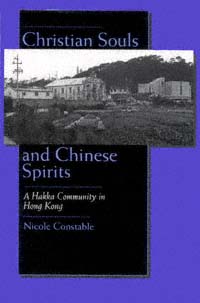 | Title: Christian souls and Chinese spirits: a Hakka community in Hong Kong Author: Constable, Nicole Published: University of California Press, 1994 Subjects: Anthropology | Cultural Anthropology | Christianity | China Publisher's Description: How do the people of a village that is both Chinese and Christian reconcile the contradictions between their religious and ethnic identities? This ethnographic study explores the construction and changing meanings of ethnic identity in Hong Kong. Established at the turn of the century by Hakka Christians who sought to escape hardships and discrimination in China, Shung Him Tong was constructed as an "ideal" Chinese and Christian village. The Hakka Christians translate "traditional" Chinese beliefs - such as ancestral worship and death rituals - that are incompatible with their Christian ideals into secular form, providing a crucial link with the past and with a Chinese identity. Despite accusations to the contrary, these villagers maintain that while they are Christian, they are still Chinese. [brief] Similar Items |
| 2. | 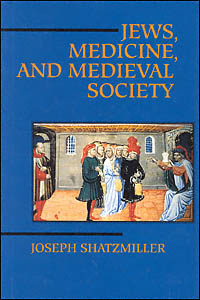 | Title: Jews, medicine, and medieval society Joseph Shatzmiller Author: Shatzmiller, Joseph Published: University of California Press, 1995 Subjects: Jewish Studies | Medieval History | European History | Medieval Studies | Medicine Publisher's Description: Jews were excluded from most professions in medieval, predominantly Christian Europe. Bigotry was widespread, yet Jews were accepted as doctors and surgeons, administering not only to other Jews but to Christians as well. Why did medieval Christians suspend their fear and suspicion of the Jews, allowing them to inspect their bodies, and even, at times, to determine their survival? What was the nature of the doctor-patient relationship? Did the law protect Jewish doctors in disputes over care and treatment?Joseph Shatzmiller explores these and other intriguing questions in the first full social history of the medieval Jewish doctor. Based on extensive archival research in Provence, Spain, and Italy, and a deep reading of the widely scattered literature, Shatzmiller examines the social and economic forces that allowed Jewish medical professionals to survive and thrive in thirteenth- and fourteenth-century Europe. His insights will prove fascinating to scholars and students of Judaica, medieval history, and the history of medicine. [brief] Similar Items |
| 3. | 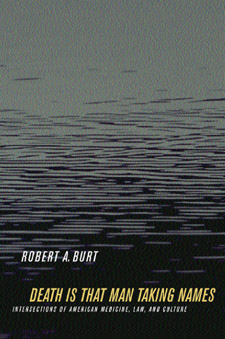 | Title: Death is that man taking names: intersections of American medicine, law, and culture Author: Burt, Robert 1939- Published: University of California Press, 2002 Subjects: Law | Health Care | History of Medicine | Ethics | Religion Publisher's Description: The American culture of death changed radically in the 1970s. For terminal illnesses, hidden decisions by physicians were rejected in favor of rational self-control by patients asserting their "right to die" - initially by refusing medical treatment and more recently by physician-assisted suicide. This new claim rested on two seemingly irrefutable propositions: first, that death can be a positive good for individuals whose suffering has become intolerable; and second, that death is an inevitable and therefore morally neutral biological event. Death Is That Man Taking Names suggests, however, that a contrary attitude persists in our culture - that death is inherently evil, not just in practical but also in moral terms. The new ethos of rational self-control cannot refute but can only unsuccessfully try to suppress this contrary attitude. The inevitable failure of this suppressive effort provokes ambivalence and clouds rational judgment in many people's minds and paradoxically leads to inflictions of terrible suffering on terminally ill people. Judicial reforms in the 1970s of abortion and capital punishment were driven by similarly high valuations of rationality and public decision-making - rejecting physician control over abortion in favor of individual self-control by pregnant women and subjecting unsupervised jury decisions for capital punishment to supposed rationally guided supervision by judges. These reforms also attempt to suppress persistently ambivalent attitudes toward death, and are therefore prone to inflicting unjustified suffering on pregnant women and death-sentenced prisoners. In this profound and subtle account of psychological and social forces underlying American cultural attitudes toward death, Robert A. Burt maintains that unacknowledged ambivalence is likely to undermine the beneficent goals of post-1970s reforms and harm the very people these changes were intended to help. [brief] Similar Items |
| 4. | 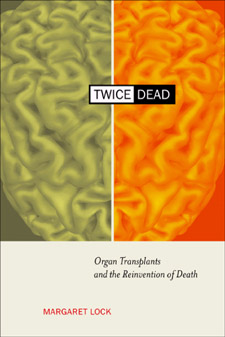 | Title: Twice dead: organ transplants and the reinvention of death Author: Lock, Margaret M Published: University of California Press, 2001 Subjects: Anthropology | Medical Anthropology | Cultural Anthropology | Ethics | Sociology | Sociology | Ethics | Sociology | Ethnic Studies | Ethnic Studies Publisher's Description: Tales about organ transplants appear in mythology and folk stories, and surface in documents from medieval times, but only during the past twenty years has medical knowledge and technology been sufficiently advanced for surgeons to perform thousands of transplants each year. In the majority of cases individuals diagnosed as "brain dead" are the source of the organs without which transplants could not take place. In this compelling and provocative examination, Margaret Lock traces the discourse over the past thirty years that contributed to the locating of a new criterion of death in the brain, and its routinization in clinical practice in North America. She compares this situation with that in Japan where, despite the availability of the necessary technology and expertise, brain death was legally recognized only in 1997, and then under limited and contested circumstances. Twice Dead explores the cultural, historical, political, and clinical reasons for the ready acceptance of the new criterion of death in North America and its rejection, until recently, in Japan, with the result that organ transplantation has been severely restricted in that country. This incisive and timely discussion demonstrates that death is not self-evident, that the space between life and death is historically and culturally constructed, fluid, multiple, and open to dispute. In addition to an analysis of that professional literature on and popular representations of the subject, Lock draws on extensive interviews conducted over ten years with physicians working in intensive care units, transplant surgeons, organ recipients, donor families, members of the general public in both Japan and North America, and political activists in Japan opposed to the recognition of brain death. By showing that death can never be understood merely as a biological event, and that cultural, medical, legal, and political dimensions are inevitably implicated in the invention of brain death, Twice Dead confronts one of the most troubling questions of our era. [brief] Similar Items |
| 5. | 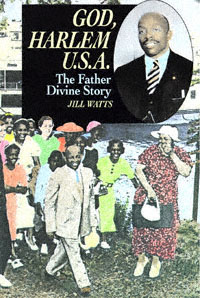 | Title: God, Harlem U.S.A.: the Father Divine story Author: Watts, Jill Published: University of California Press, 1992 Subjects: History | United States History | Christianity | American Studies | African American Studies | African Studies Publisher's Description: How did an African-American man born in a ghetto in 1879 rise to such religious prominence that his followers addressed letters to him simply "God, Harlem U.S.A."?Using hitherto unknown materials, Jill Watts portrays the life and career of one of the twentieth century's most intriguing religious leaders, Father Divine. Starting as an itinerant preacher, Father Divine built an unprecedented movement that by the 1930s had attracted followers across the nation and around the world. As his ministry grew, so did the controversy surrounding his enormous wealth, flamboyant style, and committed "angels" - black and white, rich and poor alike.Here for the first time a full account of Father Divine's childhood and early years challenges previous contentions that he was born into a sharecropping family in the deep South. While earlier biographers have concentrated on Father Divine's social and economic programs, Watts focuses on his theology, which gives new meaning to secular activities that often appeared contradictory. Although much has been written about Father Divine, God, Harlem U.S.A . finally provides a balanced and intimate account of his life's work. [brief] Similar Items |
| 6. | 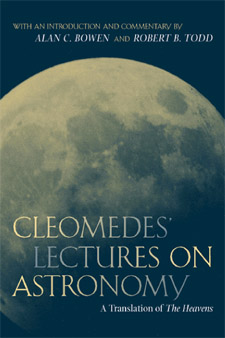 | Title: Cleomedes' lectures on astronomy: a translation of The heavens Author: Cleomedes Published: University of California Press, 2004 Subjects: Classics | Science | Astronomy | History of Science | Classical Philosophy Publisher's Description: At some time around 200 A.D., the Stoic philosopher and teacher Cleomedes delivered a set of lectures on elementary astronomy as part of a complete introduction to Stoicism for his students. The result was The Heavens (Caelestia), the only work by a professional Stoic teacher to survive intact from the first two centuries A.D., and a rare example of the interaction between science and philosophy in late antiquity. This volume contains a clear and idiomatic English translation - the first ever - of The Heavens, along with an informative introduction, detailed notes, and technical diagrams. This important work will now be accessible to specialists in both ancient philosophy and science and to readers interested in the history of astronomy and cosmology but with no knowledge of ancient Greek. [brief] Similar Items |
| 7. | 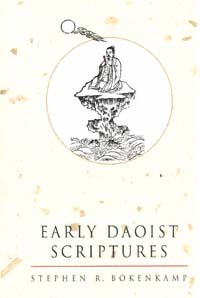 | Title: Early Daoist scriptures Author: Bokenkamp, Stephen R 1949- Published: University of California Press, 1997 Subjects: Religion | China | Classical Literature and Language | Taoism Publisher's Description: For centuries Daoism (Taoism) has played a central role in the development of Chinese thought and civilization, yet to this day only a few of its sacred texts have been translated into English. Now Stephen R. Bokenkamp introduces the reader to ancient scriptures never before published in the West, providing a systematic and easily accessible introduction to early Daoism (c. 2nd-6th C.E.). Representative works from each of the principal Daoist traditions comprise the basic structure of the book, with each chapter accompanied by an introduction that places the material within a historical and cultural context. Included are translations of the earliest Daoist commentary to Laozi's Daode jing (Tao Te Ching); historical documents relating the history of the early Daoist church; a petitioning ritual used to free believers from complaints brought against them by the dead; and two complete scriptures, one on individual meditation practice and another designed to rescue humanity from the terrors of hell through recitation of its powerful charms. In addition, Bokenkamp elucidates the connections Daoism holds with other schools of thought, particularly Confucianism and Buddhism.This book provides a much-needed introduction to Daoism for students of religion and is a welcome addition for scholars wishing to explore Daoist sacred literature. It serves as an overview to every aspect of early Daoist tradition and all the seminal practices which have helped shape the religion as it exists today. [brief] Similar Items |
| 8. | 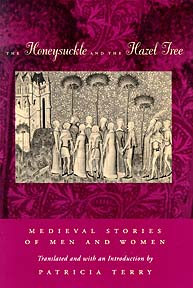 | Title: The honeysuckle and the hazel tree: medieval stories of men and women Author: Terry, Patricia Ann 1929- Published: University of California Press, 1995 Subjects: Literature | Literature in Translation | European Literature | Poetry | Literary Theory and Criticism | French Studies | Medieval Studies | Gender Studies Publisher's Description: Known for her fine translations of octosyllabic narrative verse, Patricia Terry presents translations of four major practitioners of this dominant literary form of twelfth- and thirteenth-century France. Her introduction discusses the varying views of women and love in the texts and their place in the courtly tradition.From Chrétien de Troyes Terry includes an early work, Philomena , here translated into verse for the first time. The other great writer of this period was Marie de France, the first woman in the European narrative tradition. Lanval is newly translated for this edition, which also features four of Marie's other poems. The collection further includes The Reflection by Jean Renart, known for his realistic settings; and the anonymous Chatelaine of Vergi , a fatalistic and perhaps more modern depiction of love. [brief] Similar Items |
| 9. |  | Title: Renard the Fox Author: Terry, Patricia Ann 1929- Published: University of California Press, 1992 Subjects: Literature | Poetry | Literature in Translation | Medieval Studies Publisher's Description: Renard the Fox is the first modern translation into English of one of the most important and influential medieval books. Valued for its comic spirit, its high literary quality, and its clever satire of feudal society, the tale uses animals to represent the members of various classes. This lively and . . . [more] Similar Items |
| 10. | 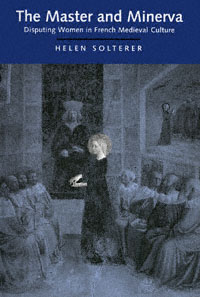 | Title: The master and Minerva: disputing women in French medieval culture Author: Solterer, Helen Published: University of California Press, 1995 Subjects: Literature | European Literature | Literary Theory and Criticism | Medieval Studies | Women's Studies | French Studies Publisher's Description: Can words do damage? For medieval culture, the answer was unambiguously yes. And as Helen Solterer contends, in French medieval culture the representation of women exemplified the use of injurious language.Solterer investigates the debates over women between masters and their disciples. Across a broad range of Old French literature to the early modern Querelle des femmes , she shows how the figure of the female respondent became an instrument for disputing the dominant models of representing women. The female respondent exploited the criterion of injurious language that so preoccupied medieval masters, and she charged master poets ethically and legally with libel. Solterer's work thus illuminates an early, decisive chapter in the history of defamation. [brief] Similar Items |
| 11. | 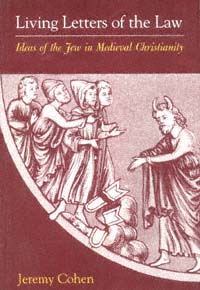 | Title: Living letters of the law: ideas of the Jew in medieval Christianity Author: Cohen, Jeremy 1953- Published: University of California Press, 1999 Subjects: Jewish Studies | Religion | Medieval History Publisher's Description: In Living Letters of the Law , Jeremy Cohen investigates the images of Jews and Judaism in the works of medieval Christian theologians from Augustine to Thomas Aquinas. He reveals how - and why - medieval Christianity fashioned a Jew on the basis of its reading of the Bible, and how this hermeneutically crafted Jew assumed distinctive character and power in Christian thought and culture.Augustine's doctrine of Jewish witness, which constructed the Jews so as to mandate their survival in a properly ordered Christian world, is the starting point for this illuminating study. Cohen demonstrates how adaptations of this doctrine reflected change in the self-consciousness of early medieval civilization. After exploring the effect of twelfth-century Europe's encounter with Islam on the value of Augustine's Jewish witnesses, he concludes with a new assessment of the reception of Augustine's ideas among thirteenth-century popes and friars.Consistently linking the medieval idea of the Jew with broader issues of textual criticism, anthropology, and the philosophy of history, this book demonstrates the complex significance of Christianity's "hermeneutical Jew" not only in the history of antisemitism but also in the broad scope of Western intellectual history. [brief] Similar Items |
| 12. | 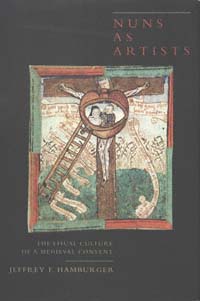 | Title: Nuns as artists: the visual culture of a medieval convent Author: Hamburger, Jeffrey F 1957- Published: University of California Press, 1997 Subjects: Art | Religion | Gender Studies | Art History | Medieval History Publisher's Description: Jeffrey F. Hamburger's groundbreaking study of the art of female monasticism explores the place of images and image-making in the spirituality of medieval nuns during the later Middle Ages. Working from a previously unknown group of late-fifteenth-century devotional drawings made by a Benedictine nun for her cloistered companions, Hamburger discusses the distinctive visual culture of female communities. The drawings discovered by Hamburger and the genre to which they belong have never been given serious consideration by art historians, yet they serve as icons of the nuns' religious vocation in all its complexity. Setting the drawings and related imagery - manuscript illumination, prints, textiles, and metalwork - within the context of religious life and reform in late medieval Germany, Hamburger reconstructs the artistic, literary, and institutional traditions that shaped the lives of cloistered women.Hamburger convincingly demonstrates the overwhelming importance of "seeing" in devotional practice, challenging traditional assumptions about the primacy of text over image in monastic piety. His presentation of the "visual culture of the convent" makes a fundamental contribution to the history of medieval art and, more generally, of late medieval monasticism and spirituality. [brief] Similar Items |
| 13. | 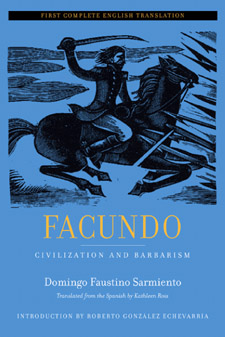 | Title: Facundo: civilization and barbarism: the first complete English translation Author: Sarmiento, Domingo Faustino 1811-1888 Published: University of California Press, 2004 Subjects: Literature | History | Latin American History | Politics | Literature in Translation Publisher's Description: A classic work of Latin American literature, Domingo Sarmiento's Facundo has become an integral part of the history, politics, and culture of Latin America since its first publication in 1845. Partially translated into English when it was first published, this foundational text appears here for the first time in its entirety. An educator and writer, Sarmiento was President of Argentina from 1868 to 1874. His Facundo is a study of the Argentine character, a prescription for the modernization of Latin America, and a protest against the tyranny of the government of Juan Manuel de Rosas (1835-1852). The book brings nineteenth-century Latin American history to life even as it raises questions still being debated today - questions regarding the "civilized" city versus the "barbaric" countryside, the treatment of indigenous and African populations, and the classically liberal plan of modernization. Facundo's celebrated and frequently anthologized portraits of the caudillo Juan Facundo Quiroga and other colorful characters give readers an exhilarating sense of Argentine culture in the making. Kathleen Ross's translation renders Sarmiento's passionate prose into English with all its richness intact, allowing the English-language reader the full experience of Facundo's intensity and historical reach. [brief] Similar Items |
| 14. | 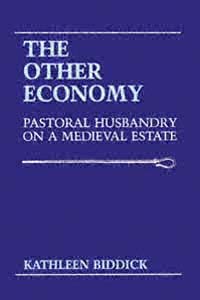 | Title: The other economy: pastoral husbandry on a medieval estate Author: Biddick, Kathleen Published: University of California Press, 1989 Subjects: History | European History | Medieval Studies Publisher's Description: While the cereal agriculture of medieval Europe has been studied exhaustively, the pastoral resources and livestock husbandry of medieval estates have been seriously neglected. Kathleen Biddick's examination of one estate, Peterborough Abbey, during several decades before and after 1100 and the first decade after 1300, brings a new balance to the subject of the medieval economy. Her pioneering methodology and the conclusions she reaches will interest archaeologists and agricultural historians as well as anthropologists, economists, and historians of early European development.Drawing on the archival records of the abbey, an estate that straddled the "classic" open-field agriculture of the English Midlands and the more pastorally-oriented farming of the English peat fens, Biddick describes in great detail how these farmers managed their herds and consumed and marketed livestock products such as meat, wool, hides, milk, and cheese. Commitment to conserving consumption strategies did not mean that the Abbey resisted market involvement and technological innovation. Large numbers of work and cart horses indicate the estate's economic interest in speedy haulage. Cereal yields, where they are calculable, compare favorably to the high-yielding demesnes of parts of Norfolk, the most agriculturally advanced region of medieval England. By showing how the Abbey coordinated its resources to enhance diversity and flexibility, The Other Economy enlarges our understanding of agrarian lordship and political control over resources in the medieval economy. [brief] Similar Items |
| 15. | 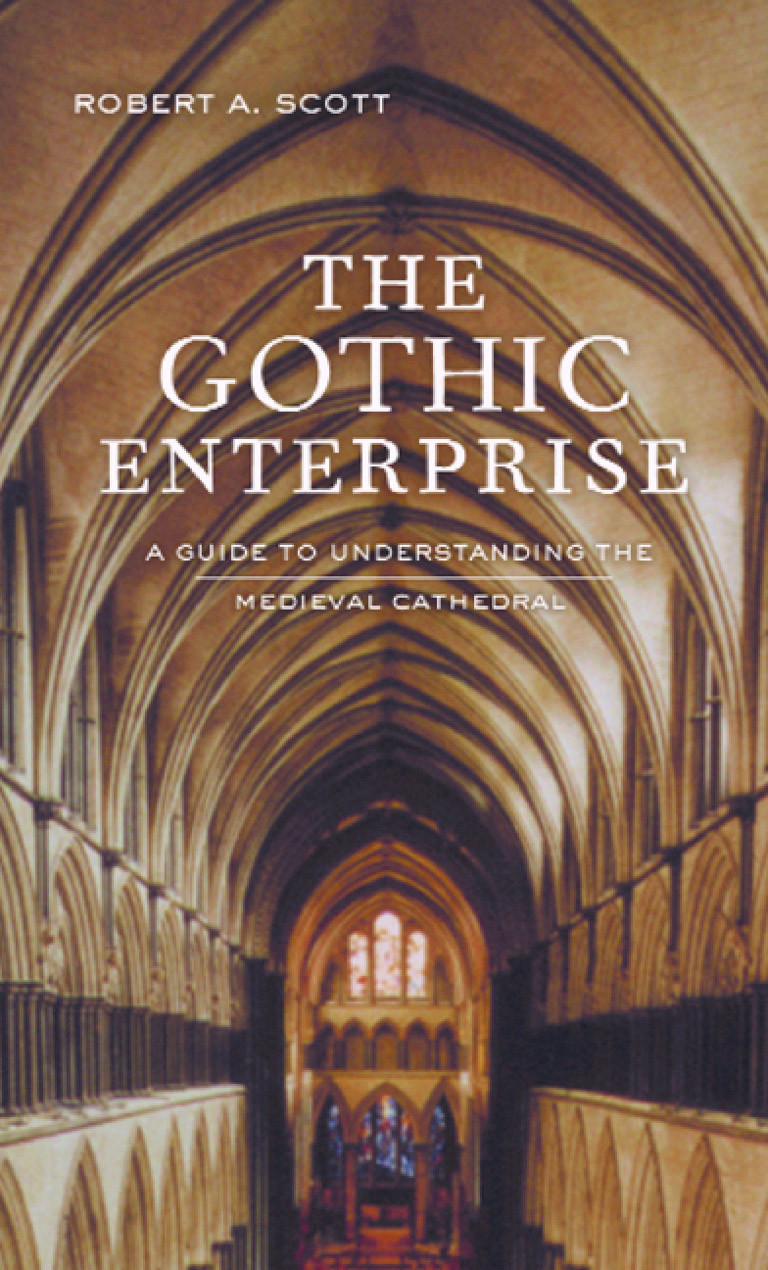 | Title: The Gothic enterprise: a guide to understanding the Medieval cathedral Author: Scott, Robert A 1935- Published: University of California Press, 2003 Subjects: Medieval Studies | Architecture | European Studies | Christianity | European History | Architectural History | Sociology | Sociology Publisher's Description: The great Gothic cathedrals of Europe are among the most astonishing achievements of Western culture. Evoking feelings of awe and humility, they make us want to understand what inspired the people who had the audacity to build them. This engrossing book surveys an era that has fired the historical imagination for centuries. In it Robert A. Scott explores why medieval people built Gothic cathedrals, how they built them, what conception of the divine lay behind their creation, and how religious and secular leaders used cathedrals for social and political purposes. As a traveler's companion or a rich source of knowledge for the armchair enthusiast, The Gothic Enterprise helps us understand how ordinary people managed such tremendous feats of physical and creative energy at a time when technology was rudimentary, famine and disease were rampant, the climate was often harsh, and communal life was unstable and incessantly violent. While most books about Gothic cathedrals focus on a particular building or on the cathedrals of a specific region, The Gothic Enterprise considers the idea of the cathedral as a humanly created space. Scott discusses why an impoverished people would commit so many social and personal resources to building something so physically stupendous and what this says about their ideas of the sacred, especially the vital role they ascribed to the divine as a protector against the dangers of everyday life. Scott's narrative offers a wealth of fascinating details concerning daily life during medieval times. The author describes the difficulties master-builders faced in scheduling construction that wouldn't be completed during their own lifetimes, how they managed without adequate numeric systems or paper on which to make detailed drawings, and how climate, natural disasters, wars, variations in the hours of daylight throughout the year, and the celebration of holy days affected the pace and timing of work. Scott also explains such things as the role of relics, the quarrying and transporting of stone, and the incessant conflict cathedral-building projects caused within their communities. Finally, by drawing comparisons between Gothic cathedrals and other monumental building projects, such as Stonehenge, Scott expands our understanding of the human impulses that shape our landscape. [brief] Similar Items |
| 16. | 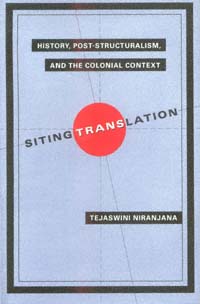 | Title: Siting translation: history, post-structuralism, and the colonial context Author: Niranjana, Tejaswini 1958- Published: University of California Press, 1992 Subjects: Postcolonial Studies | Literary Theory and Criticism | Southeast Asia | Cultural Anthropology Publisher's Description: The act of translation, Tejaswini Niranjana maintains, is a political action. Niranjana draws on Benjamin, Derrida, and de Man to show that translation has long been a site for perpetuating the unequal power relations among peoples, races, and languages. The traditional view of translation underwritten by Western philosophy helped colonialism to construct the exotic "other" as unchanging and outside history, and thus easier both to appropriate and control.Scholars, administrators, and missionaries in colonial India translated the colonized people's literature in order to extend the bounds of empire. Examining translations of Indian texts from the eighteenth century to the present, Niranjana urges post-colonial peoples to reconceive translation as a site for resistance and transformation. [brief] Similar Items |
| 17. | 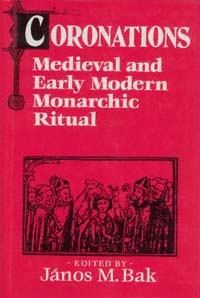 | Title: Coronations: medieval and early modern monarchic ritual Author: Bak, János M Published: University of California Press, 1990 Subjects: History | Medieval History Publisher's Description: Fascination with royal pomp and circumstance is as old as kingship itself. The authors of Coronations examine royal ceremonies from the ninth to the sixteenth century, and find the very essence of the monarchical state in its public presentation of itself. This book is an enlightened response to the revived interest in political history, written from a perspective that cultural historians will also enjoy. The symbolic and ritual acts that served to represent and legitimate monarchical power in medieval and early modern Europe include not only royal and papal coronations but also festive entries, inaugural feasts, and rulers' funerals.Fifteen leading scholars from North America, Britain, France, Germany, Poland, and Denmark explore the forms and the underlying meanings of such events, as well as problems of relevant scholarship on these subjects. All the contributions demonstrate the importance of in-depth study of rulership for the understanding of premodern power structures. Emphasis is placed on interdisciplinary approaches, drawing on the findings of ethnography and anthropology, combined with rigorous critical evaluation of the written and iconic evidence. The editor's historiographical introduction surveys the past and present of this field of study and proposes some new lines of inquiry. "For 'reality' is not a one-dimensional matter: even if we can establish what actually transpired, we still need to ask how it was perceived by those present." [brief] Similar Items |
| 18. | 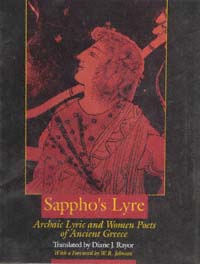 | Title: Sappho's lyre: archaic lyric and women poets of ancient Greece Author: Rayor, Diane J Published: University of California Press, 1991 Subjects: Classics | Classical Literature and Language | Literature in Translation | Poetry Publisher's Description: Sappho sang her poetry to the accompaniment of the lyre on the Greek island of Lesbos over 2500 years ago. Throughout the Greek world, her contemporaries composed lyric poetry full of passion, and in the centuries that followed the golden age of archaic lyric, new forms of poetry emerged. In this unique anthology, today's reader can enjoy the works of seventeen poets, including a selection of archaic lyric and the complete surviving works of the ancient Greek women poets - the latter appearing together in one volume for the first time. Sappho's Lyre is a combination of diligent research and poetic artistry. The translations are based on the most recent discoveries of papyri (including "new" Archilochos and Stesichoros) and the latest editions and scholarship. The introduction and notes provide historical and literary contexts that make this ancient poetry more accessible to modern readers.Although this book is primarily aimed at the reader who does not know Greek, it would be a splendid supplement to a Greek language course. It will also have wide appeal for readers of' ancient literature, women's studies, mythology, and lovers of poetry. [brief] Similar Items |
| 19. | 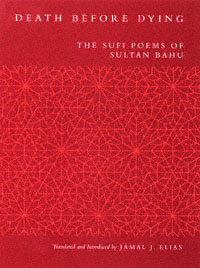 | Title: Death before dying: the Sufi poems of Sultan Bahu Author: Sult̤ān Bāhū 1630-1691 Published: University of California Press, 1998 Subjects: Literature | Religion | Poetry | Middle Eastern Studies | Literature in Translation | Islam | South Asia Publisher's Description: These 115 poems introduce readers in English to Sultan Bahu (d. 1691), a Sufi mystical poet who continues to be one of the most beloved writers in Punjabi. Bahu, whose name translates as "With God," remains highly popular in Pakistan and India today - even illiterate Punjabis can recite his poetry b . . . [more] Similar Items |
| 20. | 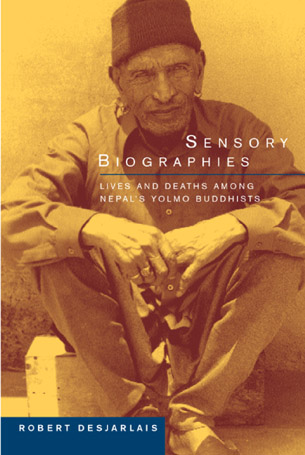 | Title: Sensory biographies: lives and deaths among Nepal's Yolmo Buddhists Author: Desjarlais, Robert R Published: University of California Press, 2003 Subjects: Anthropology | Cultural Anthropology | Buddhism | Aging Publisher's Description: Robert Desjarlais's graceful ethnography explores the life histories of two Yolmo elders, focusing on how particular sensory orientations and modalities have contributed to the making and the telling of their lives. These two are a woman in her late eighties known as Kisang Omu and a Buddhist priest in his mid-eighties known as Ghang Lama, members of an ethnically Tibetan Buddhist people whose ancestors have lived for three centuries or so along the upper ridges of the Yolmo Valley in north central Nepal. It was clear through their many conversations that both individuals perceived themselves as nearing death, and both were quite willing to share their thoughts about death and dying. The difference between the two was remarkable, however, in that Ghang Lama's life had been dominated by motifs of vision, whereas Kisang Omu's accounts of her life largely involved a "theatre of voices." Desjarlais offers a fresh and readable inquiry into how people's ways of sensing the world contribute to how they live and how they recollect their lives. [brief] Similar Items |